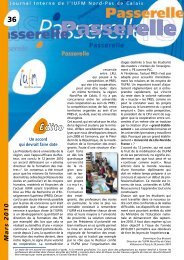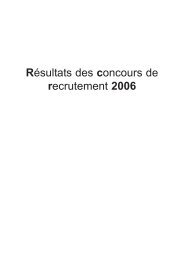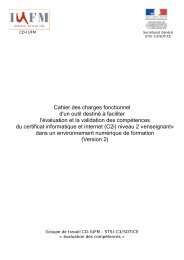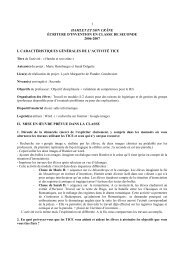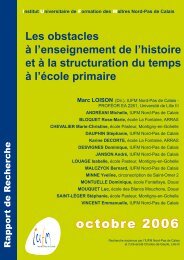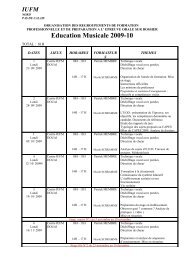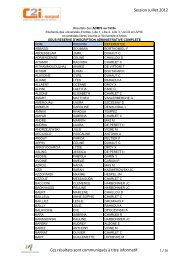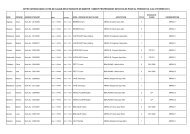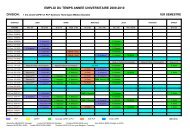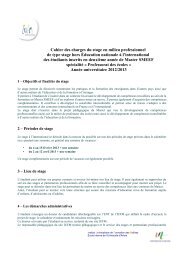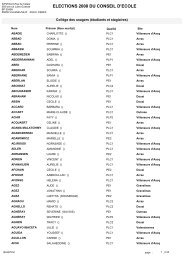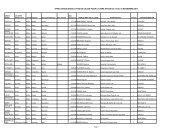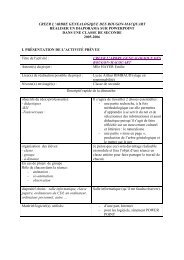You also want an ePaper? Increase the reach of your titles
YUMPU automatically turns print PDFs into web optimized ePapers that Google loves.
groups (coming from more or <strong>le</strong>ss privi<strong>le</strong>ged families). This remark makes it very c<strong>le</strong>ar that<br />
evaluating the effects of teaching methods cannot take the shape of simp<strong>le</strong> cause to affect<br />
relationships.<br />
This being said, it is in any case obvious that using S.I.A., even if it doesn’t help to find cause<br />
to effect relationships, makes it possib<strong>le</strong> to accumulate, litt<strong>le</strong> by litt<strong>le</strong>, shared behaviours,<br />
common capacities, specific mistakes etc… to groups of subjects. What is <strong>le</strong>ft to find then,<br />
is global coherence to the groups characteristics.<br />
4. Conclusion<br />
Using central prob<strong>le</strong>matic in mathematical didactics, we have been ab<strong>le</strong> to show the efficiency<br />
of dealing with S.I.A. techniques. The input of this method to analyze data cannot be<br />
disregarded for several reasons. The almost-ru<strong>le</strong>s established by S.I.A. from observab<strong>le</strong>s can<br />
easily <strong>le</strong>nd themselves to interpretation in terms of actions regulations. The implicative paths<br />
can be read in terms of networks. Lastly, the asymmetry of links seems essential to expose<br />
any explicative hypothesis of certain phenomenon pertinent to teaching and <strong>le</strong>arning. We<br />
have also been ab<strong>le</strong> to adumbrate, through the detai<strong>le</strong>d relationships of research examp<strong>le</strong>s,<br />
particular methodological behaviours : the attention to give the interpretation of the internal<br />
cohesion of implicative graphs, but also to the separation of these graphs, as well as the<br />
graphs’ nodes and of the univocal links. These are only thinking tracks to be pursued.<br />
References<br />
1. Brousseau G. : Le contrat didactique : <strong>le</strong> milieu. Recherches en didactique des<br />
mathématiques vol 3/3. La Pensée Sauvage, Grenob<strong>le</strong> (1990) (990) 309-336. 09-6.<br />
2. Brousseau G.: Théorie des situations didactiques. La Pensée Sauvage, Grenob<strong>le</strong><br />
(1998)<br />
3. Bru M., Altet M., Blanchard-Lavil<strong>le</strong> C.: À la recherche des processus caractéristiques<br />
des pratiques enseignantes dans <strong>le</strong>urs rapports aux apprentissages. Revue Française de<br />
pédagogie, n°148. INRP. Paris (2005)<br />
4. Gras R. : L’analyse des données : une méthodologie de traitement de questions de<br />
didactique. Recherches en didactique des mathématiques vol 12/1. La Pensée Sauvage,<br />
Grenob<strong>le</strong> (1992) 59-72.<br />
5. Gras R., Totohasina A, Almouloud S., Ratsimba-Rajohn H., Bail<strong>le</strong>ul M. : La méthode<br />
d’analyse implicative en didactique. Applications. In : Artigue M., Gras R., Laborde C.,<br />
Tavignot P. (eds.) : Vingt ans de didactique des mathématiques en France. La Pensée<br />
Sauvage, Grenob<strong>le</strong> (1994) 349-363.<br />
6. Gras R. : L’implication statistique, Nouvel<strong>le</strong> méthode exploratoire de données. La Pensée<br />
Sauvage, Grenob<strong>le</strong> (1996)<br />
7. Lahanier-Reuter D.: Conceptions du hasard et enseignement des probabilités et<br />
statistiques. P.UF., Paris (1999)<br />
8. Lahanier-Reuter D.: Exemp<strong>le</strong> d’une nouvel<strong>le</strong> méthode d’analyse de données : l’analyse<br />
implicative. Carrefours de l’éducation, n°9. CRDP Amiens (2000) 96-109.<br />
<strong>IUFM</strong> Nord-Pas de Calais<br />
117




